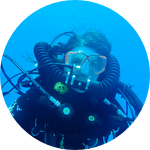About This Project
In 2014, researchers announced that Humpback whales (M. novaeangliae) are actually subspeciating and have been doing so for several hundreds of thousands of years. But is that the case? And if they are subspeciating, why is that happening? This research aims to obtain long reads for currently stored DNA samples from at least 4 different clades and, using the recently obtained full reference genome, develop a more complete phylogenetic tree of M. novaeangliae.
Ask the Scientists
Join The DiscussionWhat is the context of this research?
Humpback whales were hunted to near extinction until whaling was banned in 1963. Population recovery is slow due to long generation times and human interference. Interestingly, it seems that the near decimation of humpbacks did not lead to a bottleneck effect on their genetic variety. We previously developed the first full reference genome of M. novaeangliae, in haplotype genome format, meeting CGP standards. This project is the next phase of this research.
In 2014, Jackson et al. announced that M. novaeangliae was subspeciating and identified three subspecies. However, no additional work was done to further confirm this hypothesis. This work is meant to further understand if the equator is, in fact, a reproductive barrier.
What is the significance of this project?
Long-read sequencing and a novel reference genome would significantly advance the analysis of Humpback whale subspeciation. The extensive genetic drift and mutational divergence observed between Humpback populations, especially between ocean basins, indicate significant barriers to gene flow. Long reads can span repetitive regions and resolve complex structures, providing a more accurate understanding of the genetic differences driving subspeciation. This matters because understanding speciation is crucial for understanding diversification, which is key to guiding conservation efforts. M. novaeangliae's unique subspeciation across extensive migrations is unique but explores scale in the way few other organisms can.
What are the goals of the project?
The goal of this project is to sequence DNA samples from M. novaeangliae collected from distant populations, ideally representing different clades such as Northern Atlantic, Northern Pacific, South Pacific, South Atlantic, and Oceania. By using long-read sequencing technologies, such as the PacBio Revio HiFi Platform, we aim to generate long reads that can span repetitive regions and resolve complex genomic structures. By generating long reads from geographically distant Humpback whale populations, we can obtain a comprehensive view of their genomic diversity and evolutionary history. This information will be invaluable for testing the hypothesis of subspeciation and understanding the factors driving diversification in these magnificent creatures.
Budget
Humpback whales (Megaptera novaeangliae) are of great interest due to their behaviors and migrations, yet their evolution is poorly understood. Short-read sequencing limits our understanding, as it struggles with complex genomic regions. Long-read sequencing, like the PacBio Revio HiFi Platform, can resolve these issues. By sequencing DNA from four M. novaeangliae clades and comparing them to a reference genome and GenBank data, we aim to test the subspeciation hypothesis with more accurate data. Long reads can span repetitive regions and resolve complex structures, providing a clearer picture of M. novaeangliae evolution. This project could greatly enhance our understanding of M. novaeangliae evolution and conservation.
Endorsed by
 Project Timeline
Project Timeline
The expected research timeline is one year. Samples will be obtained from already stored tissues, thereby reducing the time and resources needed. However, obtaining the samples still required research and administrative legwork. Sequencing will take approximately one month. The bioinformatics portion for the project will take the longest, likely six months. Drafting and publication will require an additional 2-3 months.
Apr 22, 2024
Project Launched
May 03, 2024
Contact M. novaeangliae tissue repositories and request tissues.
May 17, 2024
Tissues are delivered to laboratory for sequencing.
Jun 21, 2024
Sequencing is completed and long reads are delivered electronically.
Dec 20, 2024
Team performs bioinformatics analysis, including assembly and cleanup.
Meet the Team
Maria-Vittoria Carminati
I was a lawyer for 15 years but everything changed when I saw a Humpback whale in Hawai'i in 2020. I am turning my efforts to scientific research.
In 2020, I went back to school to obtain a Bachelor's in Ecology and Evolutionary Biology with a Minor in Molecular, Cellular, and Developmental Biology. I am now a PhD student in Evolutionary Biology at CU Boulder and I am leading efforts to study speciation and hybridization as a response mechanism to climate change.
In addition, I am CEO of C2Space Tech LLC, a company that provides research and consulting for humans in the loop in high consequence environments (from underwater to high altitude and beyond).
I am fortunate to be able to work with tremendous bioinformaticians, physicians, and engineers across the continent who have been willing to guide, assist, and contribute.
I am also a scuba diving instructor, a sailor, and an adventurer at heart.
Lab Notes
Nothing posted yet.
Project Backers
- 3Backers
- 2%Funded
- $145Total Donations
- $48.33Average Donation


